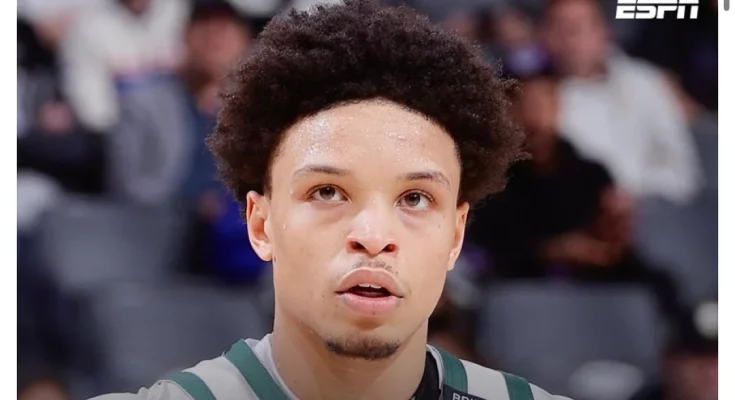Free agent guard Ryan Rollins has agreed to a three-year, \$12 million deal to return to the Milwaukee Bucks, a move that brings both continuity and potential upside to a franchise looking to solidify its backcourt depth amid a competitive Eastern Conference landscape. This decision, which might not dominate the headlines in the same way as blockbuster signings, carries deeper implications than many fans and analysts may initially realize. Rollins’ return to Milwaukee is not just about filling out a roster; it’s about building a sustainable system, balancing star power with reliable role players, and giving a young player the platform to thrive within a veteran-heavy structure.
Ryan Rollins’ journey to this point is a testament to patience, resilience, and the power of potential. Drafted 44th overall in the 2022 NBA Draft by the Golden State Warriors, Rollins came into the league as a promising but raw talent out of the University of Toledo. He was known for his smooth scoring ability, particularly in the mid-range, and his poise with the ball in his hands. However, he was not considered an NBA-ready player in his rookie year and spent significant time developing his game both in practice and in the G League. The Warriors, always looking to balance their aging championship core with young talent, saw Rollins as a long-term project. But due to injuries and a crowded backcourt, he never had the chance to carve out a consistent role in Golden State.
Eventually, Rollins was included in a trade package as the Warriors reshuffled their roster, and he landed in Milwaukee—a team with championship aspirations and a much different dynamic. Milwaukee was coming off a disappointing playoff exit and in the midst of figuring out how to best support their two stars, Giannis Antetokounmpo and Damian Lillard. Rollins was initially seen as a fringe addition, someone who could perhaps soak up minutes in the regular season but not expected to be a key rotation player. However, what followed during his short stint with the Bucks impressed both the coaching staff and front office. He exhibited growth in his decision-making, tightened up his defensive rotations, and most importantly, showed that he could contribute offensively without dominating the ball—something critical when playing next to high-usage stars like Lillard and Giannis.
By the time the season ended, Milwaukee had seen enough to believe that Rollins was worth investing in. His per-36 numbers revealed promise—he averaged nearly 14 points, 4 assists, and 3 rebounds per game when given extended minutes, while shooting over 46 percent from the field. His three-point shot, a question mark coming into the league, showed steady improvement. He worked closely with Bucks assistant coaches to refine his release mechanics and develop more confidence shooting off the catch. While he’s not yet a volume three-point shooter, the growth he’s shown suggests he’s well on his way to becoming a reliable floor spacer. More importantly, he plays within the flow of the game, doesn’t force the issue, and understands when to defer and when to assert himself.
The Bucks’ decision to give Rollins a three-year, \$12 million contract speaks volumes about their belief in his trajectory. It’s a low-risk, high-reward type of deal—financially manageable within the salary cap structure, yet long enough to allow the coaching staff to integrate him more fully into the system without worrying about losing him in free agency after one year. It’s also a signal to Rollins that he is no longer viewed as a temporary piece or a developmental afterthought. He is part of the plan. In an era where teams are looking for cost-effective contributors who can scale up in importance depending on matchup needs, Rollins fits the mold.
For the Bucks, the fit goes beyond skillset—it’s about chemistry and culture. Milwaukee has been very intentional about the type of players they bring into the fold. Veterans like Khris Middleton and Brook Lopez, and now superstars like Lillard, create a structured environment that allows younger players to develop without being overwhelmed. Rollins, with his calm demeanor and focused approach, has drawn comparisons internally to Malcolm Brogdon during his early Milwaukee days—a guard who didn’t demand the spotlight but always seemed to make the right play and was trusted in key moments. While it’s premature to project that level of impact, the Bucks are clearly optimistic about Rollins’ capacity to evolve into a similarly reliable presence.
One area where Rollins particularly shined during his initial stint with Milwaukee was in second-unit offense. When Lillard rested, the offense often stagnated due to a lack of shot creation. Rollins stepped into that void, showcasing a mid-range game that was nearly automatic when he got into rhythm. His footwork, a skill often overlooked among young guards, allowed him to create space against quicker defenders. His patience in the pick-and-roll also opened up passing angles, and he showed good chemistry with backup bigs like Bobby Portis. That’s an element Milwaukee sorely needs, especially given how much defensive attention Giannis and Lillard draw and the need to maintain offensive fluidity when they’re off the court.
Rollins’ defensive potential is also worth monitoring. He’s not a lockdown defender yet, but he possesses solid lateral quickness, a 6’10” wingspan, and a knack for reading passing lanes. The Bucks’ defensive scheme, anchored by Lopez and Giannis in the paint, allows perimeter defenders to be more aggressive on the ball. If Rollins continues to improve his footwork and learns to navigate screens more efficiently, he could evolve into a strong two-way player. It’s something the Bucks are clearly betting on by giving him a multi-year deal, allowing the team’s development staff time to work with him intensively.
From a roster construction standpoint, bringing Rollins back also makes strategic sense. The Bucks are a luxury tax team, meaning they must be shrewd about how they allocate their mid-level and minimum slots. Younger players on team-friendly deals become crucial in balancing the salary cap ledger. In that context, Rollins’ \$12 million contract over three years is a value proposition. Should he develop into a capable rotation player, Milwaukee will have secured a contributor at a fraction of the cost it would take to sign a veteran free agent to similar production.
The intangible factor in all this is the trust that has been built between Rollins and the Bucks organization. Rollins has spoken in interviews about how welcomed he felt in Milwaukee and how he was encouraged to play his game rather than try to conform to a rigid role. Head coach Doc Rivers—known for his ability to communicate with players—reportedly had several conversations with Rollins about what it would take to earn minutes and thrive within the team’s framework. That type of clear, honest feedback is invaluable for young players trying to find their footing in the league. With a sense of belonging and clarity of expectations, Rollins appears poised to take a meaningful leap.
There’s also a bigger picture here for the Bucks, one that centers on sustaining a competitive window beyond the current iteration of the roster. Lillard and Middleton are both in their 30s, and while Giannis is still very much in his prime, building a bridge to the future means identifying and developing talent that can carry forward the team’s identity. Rollins, still only 22, represents one of the few young assets with real upside on the roster. If he hits, he could become part of the next wave of Bucks contributors. If he doesn’t, the financial commitment is manageable. But Milwaukee’s actions indicate they believe this is more than just a lottery ticket—they believe Rollins has the mentality and tools to become a meaningful piece of a winning puzzle.
The Eastern Conference is not getting any easier. Teams like Boston, New York, Cleveland, and Philadelphia are all retooling, and Miami can never be counted out. Depth and versatility will be the name of the game in the playoffs, where matchups often dictate minutes. Rollins gives the Bucks another option—a combo guard who can score, facilitate, and defend. He may not start, and he may not close games consistently, but he could be the difference in key stretches, especially if injuries or fatigue hit the core group. The value of having a player who can step in and keep the system functioning cannot be overstated in today’s NBA.
As training camp approaches, the spotlight will once again turn to the Bucks’ championship ambitions, the health of their stars, and how they stack up against contenders. But beneath that spotlight, away from the headlines, Ryan Rollins will continue doing what he’s always done—working, learning, improving. His story is still being written, but this three-year deal signifies that the Bucks believe in its arc. It’s a quiet but powerful statement of faith, and if Rollins continues on his current path, it may turn out to be one of the most underrated moves of the offseason.



